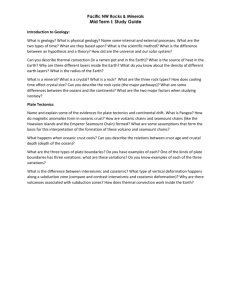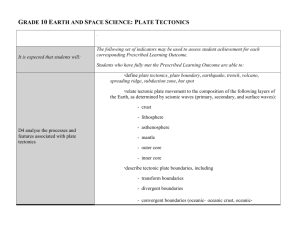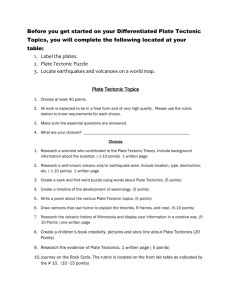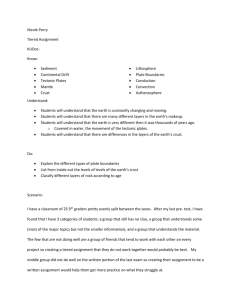Week 5A, Monday Time Lesson/Activity Materials 8:15 8:50 Elective
advertisement
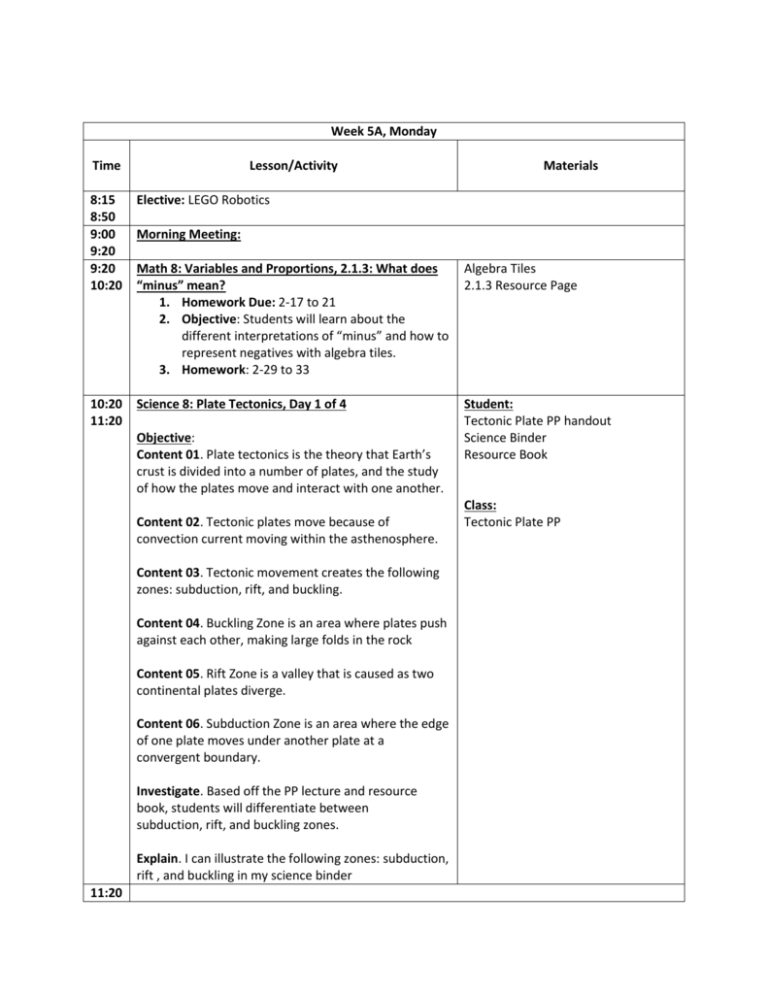
Week 5A, Monday Time Lesson/Activity Materials 8:15 8:50 9:00 9:20 9:20 10:20 Elective: LEGO Robotics Math 8: Variables and Proportions, 2.1.3: What does “minus” mean? 1. Homework Due: 2-17 to 21 2. Objective: Students will learn about the different interpretations of “minus” and how to represent negatives with algebra tiles. 3. Homework: 2-29 to 33 Algebra Tiles 2.1.3 Resource Page 10:20 11:20 Science 8: Plate Tectonics, Day 1 of 4 Student: Tectonic Plate PP handout Science Binder Resource Book Morning Meeting: Objective: Content 01. Plate tectonics is the theory that Earth’s crust is divided into a number of plates, and the study of how the plates move and interact with one another. Content 02. Tectonic plates move because of convection current moving within the asthenosphere. Content 03. Tectonic movement creates the following zones: subduction, rift, and buckling. Content 04. Buckling Zone is an area where plates push against each other, making large folds in the rock Content 05. Rift Zone is a valley that is caused as two continental plates diverge. Content 06. Subduction Zone is an area where the edge of one plate moves under another plate at a convergent boundary. Investigate. Based off the PP lecture and resource book, students will differentiate between subduction, rift, and buckling zones. Explain. I can illustrate the following zones: subduction, rift , and buckling in my science binder 11:20 Class: Tectonic Plate PP 12:10 12:10 1:00 Recess/Lunch Math 7: Probability and Portions, Chapter 1 Closure 1. Homework Due: 133-137 2. Objective: Students will reflect about what they have learned. 3. Homework: Any concepts that students still have difficulty obtaining 1:00 2:00 Science 7: Diversity of Life, Investigation 3, Paramecia. Part 2 Objective: Content01. Paramecia have shape, a membrane, cilia, an oral groove, and organelles, including vacuoles. Investigate. Observe structure and behavior of singlecelled microorganisms with a microscope. Compare paramecium cells to Elodea cells. Explain. Generate evidence to support the idea that single-celled paramecia are organisms 2:00 2:50 2:50 3:00 Special MS Door None Group: Microscope Microscope kit Colored pencils Lad notebook page 16-17 Resource Book, pg. 24 Class: Petri dishes Droppers Paramecium Tap water Tuesday Time Lesson/Activity Materials 8:15 9:00 9:00 9:20 9:20 10:20 Elective: LEGO Robotics Math 8: Variables and Proportions, 2.1.4: What makes zero? 1. Homework Due: 2-29 to 33 2. Objective: Students will deepen their understanding of the concept of zero and will learn how to represent zero in multiple ways with algebra tiles. 3. Homework: 2-41 to 46 Algebra Tiles 2.1.3. Resource Page 10:20 11:20 Science 8: Plate Tectonics, Day 2 of 4 Student: Tectonic Plate PP handout Science Binder Laptop, Google Earth Oceanic-Ridges activity sheet Morning Meeting Objective: Content 01. Plates are created in divergent boundaries. Content 02. Divergent Boundary is a boundary where two plates are moving away from each other. Content 03. Diverging plates are moving away from one another due to convention currents found in the asthenosphere. Content 04. Convection Currents are the cyclical movements that occur when warm, less-dense fluid rises rise and cool, and more-dense fluids sink due to differences in temperature. Content 05. Ocean-floor Spreading is the process by which new ocean floor is created in the area where two plates are moving apart. Content 06. Mid-ocean Ridges are continuous mountain ranges through the oceans. Mid-ocean ridges are divergent plate boundaries and are the site of seafloor spreading and the formation of new oceanic crust. Investigate. Use Google Earth to locate mid-ocean ridges on Earth. Explain. I can locate mid-ocean ridges, on Earth, and Class: Tectonic Plate PP collect the following information about them: Which oceans, How long are they, and which continents do they move (grow) toward. 11:20 12:10 Recess/Lunch 12:10 1:00 Math 7: Probability and Portions, Chapter 1 Test 4. Homework Due: None 5. Objective: Successfully finish chapter 1 test 6. Homework: None chapter 1 test 1:00 2:00 Science 7: Diversity of Life, Investigation 4, The Cell. Part 1 Group: Microscopes Microscope kit Lab notebook, pg. 27 Objective: Content 01. Human, and all other complex life-forms, are made of cells. Investigate. Prepare a wet mount to observe cheek scrapings and see evidence that humans, too, are made of cells. Explain. Students will complete the check investigation handout. 2:00 2:50 2:50 3:00 Special MS Door Class: Methylene blue Wednesday Time Lesson/Activity Materials 8:15 9:00 9:00 9:20 9:20 10:20 Elective: LEGO Robotics Math 8: Variables and Proportions, 2.1.5: Using algebra tiles to simplify algebraic expressions 1. Homework Due: 41-46 2. Objective: Students will build and simplify algebraic expressions using the tiles and begin to use expression comparison mats to determine whether two expressions are the same or different. 3. Homework: 52-56 2.1.5.A/B Resource Pages Algebra Tiles 10:20 11:20 Science 8: Plate Tectonics, Day 3 of 4 Student: Laptop, Google Earth Tectonic Plate PP handout Science Binder Resource Book Subduction Zones Activity Sheet Morning Meeting Objective: Content 01. Tectonic plates, at a convergent boundary, are where they are moving toward each other. Content 02. Subduction Zone is an area where the edge of one plate moves under another plate at a convergent boundary. Content 03. The following Earth structures are formed in a subduction zone: trenches, oceanic crust is recycled, and volcanoes can form. Content 04. Trench is an Earth structure, with long, steep sides and a deep depression formed at a convergent boundary when an oceanic plate moves under another plate. Content 05. Oceanic Crust is the parts of the Earth’s crust that are under the ocean; these are the thinnest parts. Content 06. Continental Crust is the part of Earth’s crust that forms the continents; these are the thickest parts. Content 07. The recycling of oceanic crust is due to the convection currents found in the asthenosphere. Class: Tectonic Plate PP Investigate. Use Google Earth to locate Subduction Zones on Earth. Explain. I can locate subduction zones, on Earth, and collect the following information about them: Which oceans, which continents are they located on, and name a minimum of 10 volcanoes found along subduction zones. 11:20 12:10 12:10 1:00 1:00 2:00 Recess/Lunch Math 7: Probability and Portions, Chapter 1 Test 7. Homework Due: None 8. Objective: Fix chapter 1 test 9. Homework: None Science 7: Diversity of Life, Investigation 4, The Cell. Part 2, Day 1 of 3 Objective: Content 01. A major subdivision in cells is whether they have a nucleus (eukaryote) or not (prokaryote). Corrected chapter 1 test Class: Diversity of Life Resource Book, pg. 27 Lab Notebook, PP 28-29 Cell PP Content 02. Bacteria have prokaryotic cells; all other life forms have eukaryotic cells. Content 03. Cells have defining structures, such as membranes, cell walls, nuclei, chloroplasts, ribosomes, mitochondria, and cytoplasm. Content 04. Cells are the basic unit of life Content 05. All life is aquatic at the cellular level. Investigate. From the cells PP and the resource book pages, Cell: The Basic Unit of Life, to differentiate between prokaryotic and eukaryotic cells. Explain. Complete Ribbon of Life questions found in the lab notebook, pages 28-29 2:00 2:50 2:50 3:00 Special MS Door Cell PP Student Handout Thursday Time 8:15 9:00 9:00 9:20 9:00 9:20 9:20 10:20 Lesson/Activity Elective: LEGO Robotics Materials Morning Meeting Math 8: Variables and Proportions, 2.1.6: Using algebra tiles to compare expressions 4. Homework Due: 52-56 5. Objective: Students will practice simplifying algebraic expressions using algebra tiles and will use an expression comparison mat to determine which of two expressions is greater. 6. Homework: 59-63 Science 8: Plate Tectonics, Day 4 of 5 Objective: Content 01. Plate Tectonics provides a unifying picture of the dynamic features of Earth’s lithosphere, accounting for the distributions of plants and animals, volcanoes, earthquakes, mid-ocean ridges, and the three basic kinds of faults. Content 02. Distribution of fossils and glacial deposits form coherent patterns if landmasses are reassembled to form Gondwanaland. Content 03. Magma frompartial melting of oceanic crust rises to form a volcanic arc parallel to a subduction zone Content 04. Mirror-image striping of normal and reversed rock magnetism on the two sides of a midocean ridge reflects episodic reversals of Earth’s magnetic field. Content 05. Radiometric dating of volcanoes formed by a stationary hot spot can reveal the rate of movement of a oceanic plate. Content 06: Each of the three basic kinds of faults is characteristic of one of the three types of plate boundaries. Earthquakes result from movements along these faults. Investigate. Before PP presentation, collect evidence Algebra Tiles Expression Comparison mat Group: Laptop, internet access Poster paper Markers/pencils Tape Research items sheet Class: Plate Tectonic PP, Day 4 Handout Plate Tectonic PP Science Binder from the internet to support The Theory of Plate Tectonics. Each group will be given a sheet of topics to begin their investigation. Each student will place their collected research in their science binder. Explain. In groups, students will work in groups of four to create posters presenting the evidence for Plate Tectonics Thoery. 10:20 11:20 11:20 12:10 12:10 1:00 Recess/Lunch Math 7: Transformation and Area, 2.1.1: Adding positives and negative numbers 1. Homework Due: None 2. Objective: Students will connect movement along a number line with the addition of positrive and negative numbers. 3. Homework: 2-7 to 12 Science 7: Diversity of Life, Investigation 4, The Cell. Part 2, Day 2 of 3 Objective: Content 01. A major subdivision in cells is whether they have a nucleus (eukaryote) or not (prokaryote). Content 02. Bacteria have prokaryotic cells; all other life forms have eukaryotic cells. Content 03. Cells have defining structures, such as membranes, cell walls, nuclei, chloroplasts, ribosomes, mitochondria, and cytoplasm. Content 04. Cells are the basic unit of life Content 05. All life is aquatic at the cellular level. Investigate. From the cells PP and Cell: The Basic Unit of Life, to differentiate between prokaryotic and eukaryotic cells. 2:00 2:50 2:50 3:00 Explain. Students will create a 3-dimensional model of a eukaryotic or prokaryotic cell with labels of major structures found within. Special MS Door 2.1.1 Resource Page Class: Resources: a. Cell PP Handout b. Resource Book, pg. 27 c. www.Biology4kids.org Materials to make cells: Friday Time 8:15 9:00 9:00 9:20 9:20 10:10 10:10 11:15 Lesson/Activity Elective: LEGO Robotics Materials Morning Meeting Math 8: Variables and Proportions, 2.1.7: Simplifying and Recording Work 1. Homework Due: 59-63 2. Objective: Students will practice how to record their work in order to show their solution steps as well as simplify algebraic expressions. 3. Homework: 68-71 Science 8: Plate Tectonics, Day 5 of 5 Objective: Content 01. Plate Tectonics provides a unifying picture of the dynamic features of Earth’s lithosphere, accounting for the distributions of plants and animals, volcanoes, earthquakes, mid-ocean ridges, and the three basic kinds of faults. Content 02. Distribution of fossils and glacial deposits form coherent patterns if landmasses are reassembled to form Gondwanaland. Content 03. Magma frompartial melting of oceanic crust rises to form a volcanic arc parallel to a subduction zone Content 04. Mirror-image striping of normal and reversed rock magnetism on the two sides of a midocean ridge reflects episodic reversals of Earth’s magnetic field. Content 05. Radiometric dating of volcanoes formed by a stationary hot spot can reveal the rate of movement of a oceanic plate. Content 06: Each of the three basic kinds of faults is characteristic of one of the three types of plate boundaries. Earthquakes result from movements along these faults. Investigate. Before PP presentation, collect evidence from the internet to support The Theory of Plate Algebra Tiles Expression Comparison mat Group: Laptop, internet access Poster paper Markers/pencils Tape Research items sheet Class: Plate Tectonic PP, Day 4 Handout Plate Tectonic PP Science Binder Tectonics. Each group will be given a sheet of topics to begin their investigation. Each student will place their collected research in their science binder. Explain. In groups, students will work in groups of four to create posters presenting the evidence for Plate Tectonics Theory. 11:15 12:00 12:10 1:00 1:00 2:00 Recess/Lunch Math 7: Transformation and Area, 2.1.2: Adding and Subtracting integers, Day 1 of 2 1. Homework Due: 7-12 2. Objective: Students will connect adding a negative number with subtracting a positive number, and will begin to generalize how to tell if a sum will be positive, negative, or zero. 3. Homework: 2-26 to 30 Science 7: Diversity of Life, Investigation 4, The Cell. Part 2, Day 3 of 3 Objective: Content 01. A major subdivision in cells is whether they have a nucleus (eukaryote) or not (prokaryote). Content 02. Bacteria have prokaryotic cells; all other life forms have eukaryotic cells. Content 03. Cells have defining structures, such as membranes, cell walls, nuclei, chloroplasts, ribosomes, mitochondria, and cytoplasm. Content 04. Cells are the basic unit of life Content 05. All life is aquatic at the cellular level. Investigate. From the cells PP and Cell: The Basic Unit of Life, to differentiate between prokaryotic and eukaryotic cells. 2:00 2:50 2:50 Explain. Students will create a 3-dimensional model of a eukaryotic or prokaryotic cell with labels of major structures found within. Special MS Door 2.1.2 Resource Page Class: Resources: d. Cell PP Handout e. Resource Book, pg. 27 f. www.Biology4kids.org Materials to make cells

